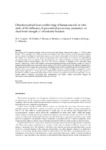Mostrar o rexistro simple do ítem
Ultrashort pulsed laser conditioning of human enamel: in vitro study of the influence of geometrical processing parameters on shear bond strength of orthodontic brackets
| dc.contributor.author | Lorenzo, M.C. | |
| dc.contributor.author | Portillo, M. | |
| dc.contributor.author | Montero, Javier | |
| dc.contributor.author | García, A. | |
| dc.contributor.author | Santos-del-Riego, Sergio | |
| dc.contributor.author | Albadalejo, Alberto | |
| dc.date.accessioned | 2016-05-06T07:16:15Z | |
| dc.date.available | 2016-05-06T07:16:15Z | |
| dc.date.issued | 2013-11-19 | |
| dc.identifier.citation | Lorenzo MC, Portillo M, Moreno P, et al. Ultrashort pulsed laser conditioning of human enamel: in vitro study of the influence of geometrical processing parameters on shear bond strength of orthodontic brackets. Lasers Med Sci. 2015;30(2):891-900 | es_ES |
| dc.identifier.uri | http://hdl.handle.net/2183/16616 | |
| dc.description.abstract | [Abstract] The surfaces of 63 extracted premolar teeth were processed with intense ultrashort laser pulses (λ = 795 nm; pulse duration, 120 fs; repetition rate, 1 kHz) to produce cross patterns with different pitches (s) in the micrometer range in order to evaluate the influence of such microstructures on the shear bond strengths of orthodontic brackets to enamel. The samples were classified in nine groups corresponding to the control group (raw samples) and eight different laser-processed groups (cross patterns with s increasing from 15 to 180 μm). Brackets were luted with TransbondTM XT adhesive resin to all the samples; after 72 h, they all were submitted to strength test in a universal testing machine. Additionally, a third of the samples underwent morphological analysis of the debonded surface by means of scanning electron microscope microscopy and an analysis of the failure mode based on the adhesive remnant index. The results showed that enamel microstructuring with ultrashort laser pulses remarkably increase the bond strength of brackets. Dense cross patterns (s < 90 μm) produce the highest increase of bond strengths as compared to control group whereas light ones (s > 90 μm) give rise to smaller improvements of the bond strength. A strong correlation of this behavior with the predominant failure mode in both scenarios was found. So far, the best compromise between suitable adhesive efficiency, processing time minimization, and enamel surface preservation suggests the performance of cross patterns with pitches in the order of 90 μm. | es_ES |
| dc.description.sponsorship | Ministerio de Economía y Competitividad; CSD2007-00013 | es_ES |
| dc.description.sponsorship | Ministerio de Economía y Competitividad; FIS2009-0952 | es_ES |
| dc.description.sponsorship | Castilla y León. Junta; SA086A12-2 | es_ES |
| dc.language.iso | eng | es_ES |
| dc.publisher | Springer | es_ES |
| dc.relation.uri | http://dx.doi.org/10.1007/s10103-013-1491-2 | es_ES |
| dc.rights | The final publication is avaliable at Springer Link | es_ES |
| dc.subject | Femtosecond laser | es_ES |
| dc.subject | Enamel | es_ES |
| dc.subject | Adhesion | es_ES |
| dc.subject | Shear bond strength | es_ES |
| dc.title | Ultrashort pulsed laser conditioning of human enamel: in vitro study of the influence of geometrical processing parameters on shear bond strength of orthodontic brackets | es_ES |
| dc.type | info:eu-repo/semantics/article | es_ES |
| dc.rights.access | info:eu-repo/semantics/openAccess | es_ES |
| UDC.journalTitle | Lasers in Medical Science | es_ES |
| UDC.volume | 30 | es_ES |
| UDC.issue | 2 | es_ES |
| UDC.startPage | 891 | es_ES |
| UDC.endPage | 900 | es_ES |
Ficheiros no ítem
Este ítem aparece na(s) seguinte(s) colección(s)
-
II - Artigos [434]






